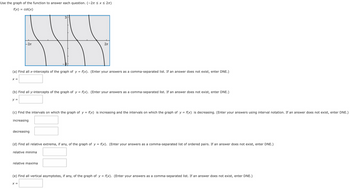
Trigonometry (11th Edition)
11th Edition
ISBN: 9780134217437
Author: Margaret L. Lial, John Hornsby, David I. Schneider, Callie Daniels
Publisher: PEARSON
expand_more
expand_more
format_list_bulleted
Question

Transcribed Image Text:Use the graph of the function to answer each question. (-2 ≤ x ≤ 2π)
f(x) = cot(x)
-2π
3
2π
(a) Find all x-intercepts of the graph of y = f(x). (Enter your answers as a comma-separated list. If an answer does not exist, enter DNE.)
x =
(b) Find all y-intercepts of the graph of y = f(x). (Enter your answers as a comma-separated list. If an answer does not exist, enter DNE.)
y =
(c) Find the intervals on which the graph of y = f(x) is increasing and the intervals on which the graph of y = f(x) is decreasing. (Enter your answers using interval notation. If an answer does not exist, enter DNE.)
increasing
decreasing
(d) Find all relative extrema, if any, of the graph of y = f(x). (Enter your answers as a comma-separated list of ordered pairs. If an answer does not exist, enter DNE.)
relative minima
relative maxima
(e) Find all vertical asymptotes, if any, of the graph of y = f(x). (Enter your answers as a comma-separated list. If an answer does not exist, enter DNE.)
x =
SAVE
AI-Generated Solution
info
AI-generated content may present inaccurate or offensive content that does not represent bartleby’s views.
Unlock instant AI solutions
Tap the button
to generate a solution
to generate a solution
Click the button to generate
a solution
a solution
Knowledge Booster
Similar questions
- Type an ordered pair. Use a comma to separate answers as needed. Round to the nearest hundredth as needed.arrow_forwardFind the 2- and y-intercepts for the function. Enter your answers as points, (a, b). The x-intercept is (-5.0) The y-intercept is (0.1/5) 20 X AH ΩΣ ΤΟ Show your work and explain, in your own words, how you arrived at your answers. There are sample student explanations in the feedback to questions 3, 5, 9, and 14 that show the level of detail that is expected in your explanations. GOCA FE f(x) = D BA x+5 x²+25 學版 A- A- I Styles E BIUS X, x² Font Submit Assignment Size Quit & Save ES Back 8 Question Menu . May 6 4:17 US Nearrow_forwardUse the graph of y f(x) below to sketch a graph of y=(x). OA. OB. OC. OD. t Choose the correct graph on the right that shows the inverse as a dotted line. raarrow_forward
arrow_back_ios
arrow_forward_ios
Recommended textbooks for you
 Trigonometry (11th Edition)TrigonometryISBN:9780134217437Author:Margaret L. Lial, John Hornsby, David I. Schneider, Callie DanielsPublisher:PEARSON
Trigonometry (11th Edition)TrigonometryISBN:9780134217437Author:Margaret L. Lial, John Hornsby, David I. Schneider, Callie DanielsPublisher:PEARSON Trigonometry (MindTap Course List)TrigonometryISBN:9781305652224Author:Charles P. McKeague, Mark D. TurnerPublisher:Cengage Learning
Trigonometry (MindTap Course List)TrigonometryISBN:9781305652224Author:Charles P. McKeague, Mark D. TurnerPublisher:Cengage Learning
 Trigonometry (MindTap Course List)TrigonometryISBN:9781337278461Author:Ron LarsonPublisher:Cengage Learning
Trigonometry (MindTap Course List)TrigonometryISBN:9781337278461Author:Ron LarsonPublisher:Cengage Learning

Trigonometry (11th Edition)
Trigonometry
ISBN:9780134217437
Author:Margaret L. Lial, John Hornsby, David I. Schneider, Callie Daniels
Publisher:PEARSON

Trigonometry (MindTap Course List)
Trigonometry
ISBN:9781305652224
Author:Charles P. McKeague, Mark D. Turner
Publisher:Cengage Learning


Trigonometry (MindTap Course List)
Trigonometry
ISBN:9781337278461
Author:Ron Larson
Publisher:Cengage Learning